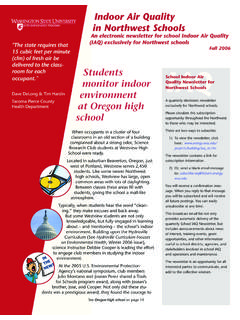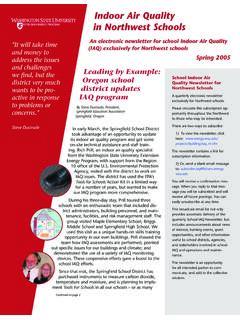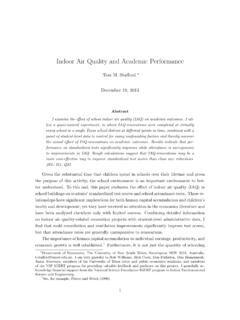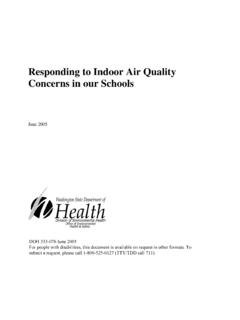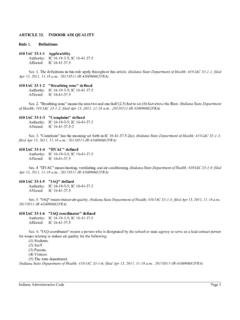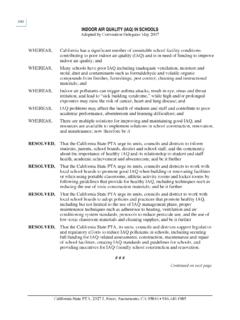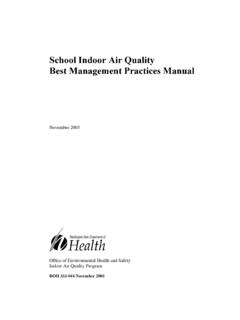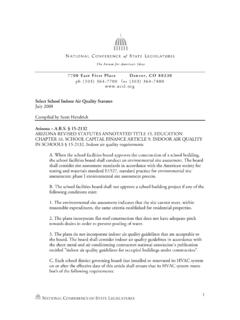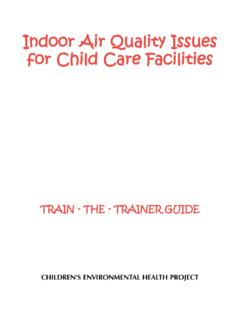Transcription of METHODS FOR MONITORING INDOOR AIR QUALITY IN …
1 The WHO Regional Office for Europe The World Health Organization (WHO) is a specialized agency of the United Nations created in 1948 with the primary responsibility for international health matters and public health. The WHO Regional Office for Europe is one of six regional offices throughout the world, each with its own programme geared to the particular health conditions of the countries it serves. Member States Albania Andorra Armenia Austria Azerbaijan Belarus Belgium Bosnia and Herzegovina Bulgaria Croatia Cyprus Czech Republic Denmark Estonia Finland France Georgia Germany Greece Hungary Iceland Ireland Israel Italy Kazakhstan Kyrgyzstan Latvia Lithuania Luxembourg Malta Monaco Montenegro Netherlands Norway Poland Portugal Republic of Moldova Romania Russian Federation San Marino Serbia Slovakia Slovenia Spain Sweden Switzerland Tajikistan The former Yugoslav Republic of Macedonia Turkey
2 Turkmenistan Ukraine United Kingdom Uzbekistan Original: English METHODS FOR MONITORING INDOOR AIR QUALITY IN SCHOOLS METHODS for MONITORING INDOOR air QUALITY in schools Report of a meeting Bonn, Germany 4-5 April 2011 World Health Organization Regional Office for Europe Scherfigsvej 8, DK-2100 Copenhagen , Denmark Tel.: +45 39 17 17 17. Fax: +45 39 17 18 18. E-mail: Web site: METHODS for MONITORING INDOOR air QUALITY in schools Report from the meeting 4-5 April 2011 Bonn.
3 Germany The meeting was cosponsored by the Joint Research Centre of the European Commission ABSTRACT A WHO consultation in November 2010 selected a set of environmental health indicators for MONITORING the implementation of time bound commitments to reduce health effects of environmental hazards in children that were adopted by Member States at the Fifth Ministerial Conference on Environment and Health in Parma (2010). New indicators addressing exposure to selected INDOOR air pollutants in the school environment, moulds and dampness in school buildings, and insufficient ventilation in classrooms will require new data collection in Member States.
4 This technical meeting co-sponsored by WHO and the Joint Research Centre of European Commission defined methodological approaches for national surveys in schools, set schedule for further methodology development, pilot testing and preparation of guidelines. Keywords AIR POLLUTION, INDOOR prevention and control SCHOOLS ENVIRONMENTAL MONITORING AIR POLLUTANTS adverse effects CHILD Address requests about publications of the WHO Regional Office for Europe to: Publications WHO Regional Office for Europe Scherfigsvej 8 DK-2100 Copenhagen , Denmark Alternatively, complete an online request form for documentation, health information, or for permission to quote or translate, on the Regional Office web site ( ).
5 World Health Organization 2011 All rights reserved. The Regional Office for Europe of the World Health Organization welcomes requests for permission to reproduce or translate its publications, in part or in full. The designations employed and the presentation of the material in this publication do not imply the expression of any opinion whatsoever on the part of the World Health Organization concerning the legal status of any country, territory, city or area or of its authorities, or concerning the delimitation of its frontiers or boundaries.
6 Dotted lines on maps represent approximate border lines for which there may not yet be full agreement. The mention of specific companies or of certain manufacturers products does not imply that they are endorsed or recommended by the World Health Organization in preference to others of a similar nature that are not mentioned. Errors and omissions excepted, the names of proprietary products are distinguished by initial capital letters. All reasonable precautions have been taken by the World Health Organization to verify the information contained in this publication.
7 However, the published material is being distributed without warranty of any kind, either express or implied. The responsibility for the interpretation and use of the material lies with the reader. In no event shall the World Health Organization be liable for damages arising from its use. The views expressed by authors, editors, or expert groups do not necessarily represent the decisions or the stated policy of the World Health Organization. CONTENTS Page BACKGROUND AND PREPARATION OF THE 1 SUMMARY OF MEETING DISCUSSIONS.
8 2 MEETING OBJECTIVES AND 2 OVERVIEW OF APPROACHES AND 3 PRESENTATIONS ON EXISTING INDOOR AIR POLLUTION SURVEILLANCE PROGRAMS IN 3 3 Belgium .. 4 Italy .. 4 Schools INDOOR Pollution and Health: Observatory Network In Europe (SINPHONIE) .. 4 Overview of application of INDOOR air QUALITY MONITORING METHODS in European surveillance programs .. 5 SURVEY 6 MONITORING exposure to chemical INDOOR air pollutants .. 6 Methodology of INDOOR air exchange rate MONITORING .. 10 Methodology for evaluating the presence of dampness and mould in schools.
9 12 Survey design and sample size .. 14 CONCLUSIONS, RECOMMENDATIONS AND WAY 23 ANNEX 1. LIST OF 25 METHODS for MONITORING INDOOR air QUALITY in schools page 1 Background and preparation of the meeting The Fifth Ministerial Conference on Environment and Health (Parma, Italy, 2010) adopted the Declaration and the Commitment to Act containing the set of targets for the environment and health (EH) process under four Regional Priority Goals (RPGs): (1) Ensuring public health by improving access to safe water and sanitation.
10 (2) Addressing obesity and injuries through safe environments, physical activity and healthy diets; (3) Preventing disease through improved INDOOR and outdoor air QUALITY ; and (4) Preventing disease arising from chemical, biological and physical environments. For the first time in history, it set time-bound targets for the implementation of specific commitments to act to protect children s health. The 60th Session of the WHO Regional Committee for Europe, Moscow, September 2010, directed WHO Europe to support Member States in their efforts to implement Parma commitments.










